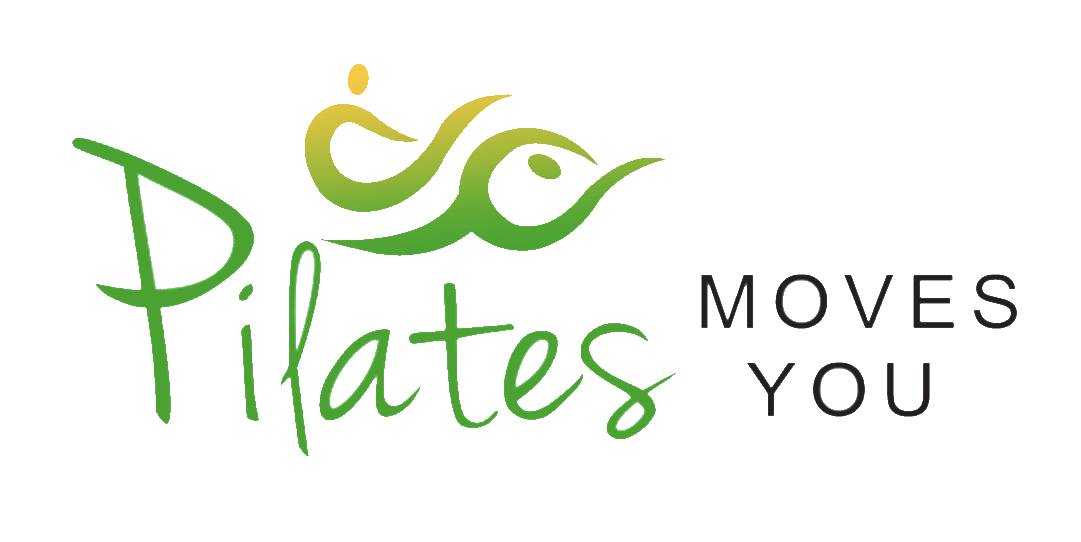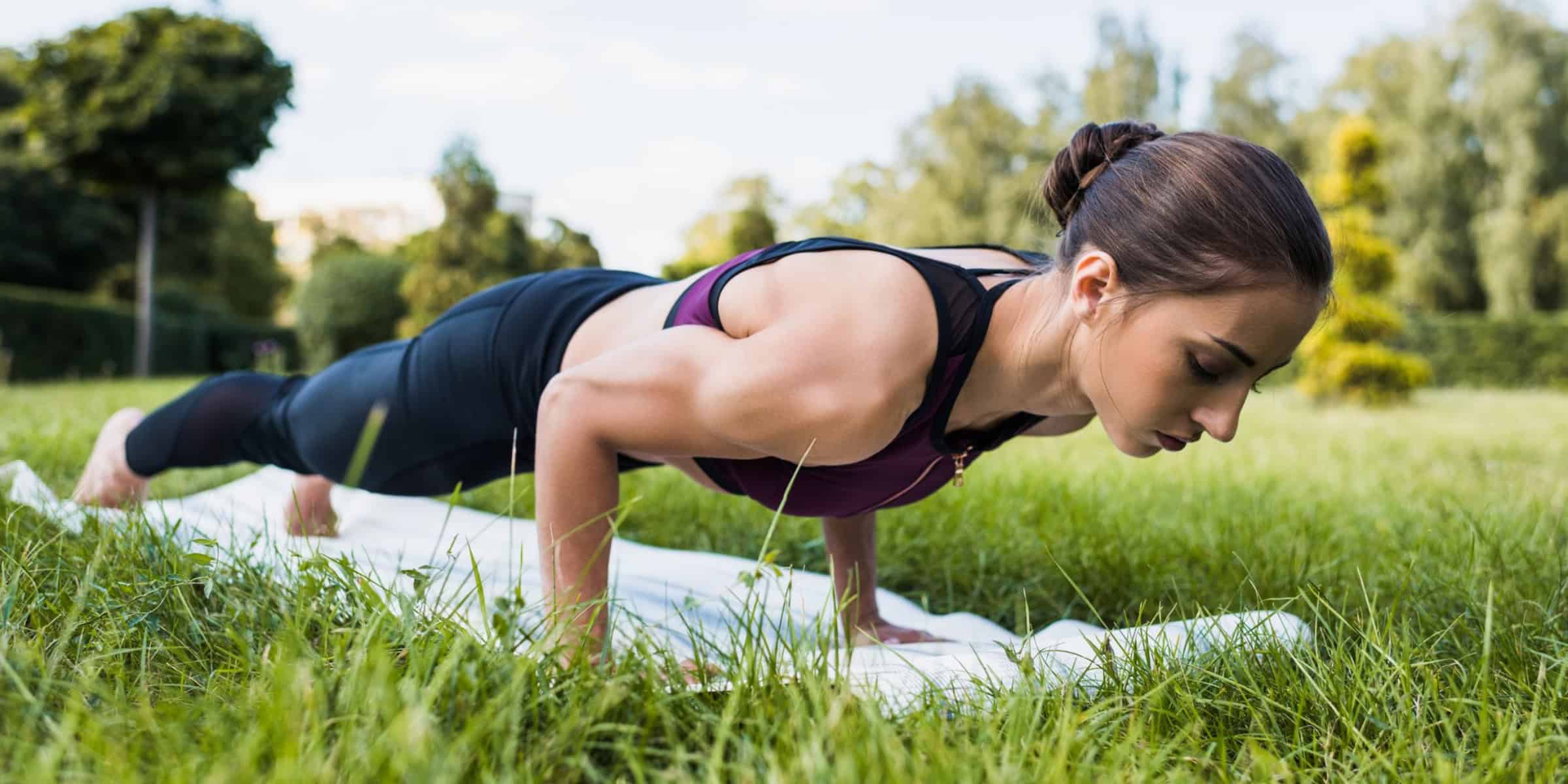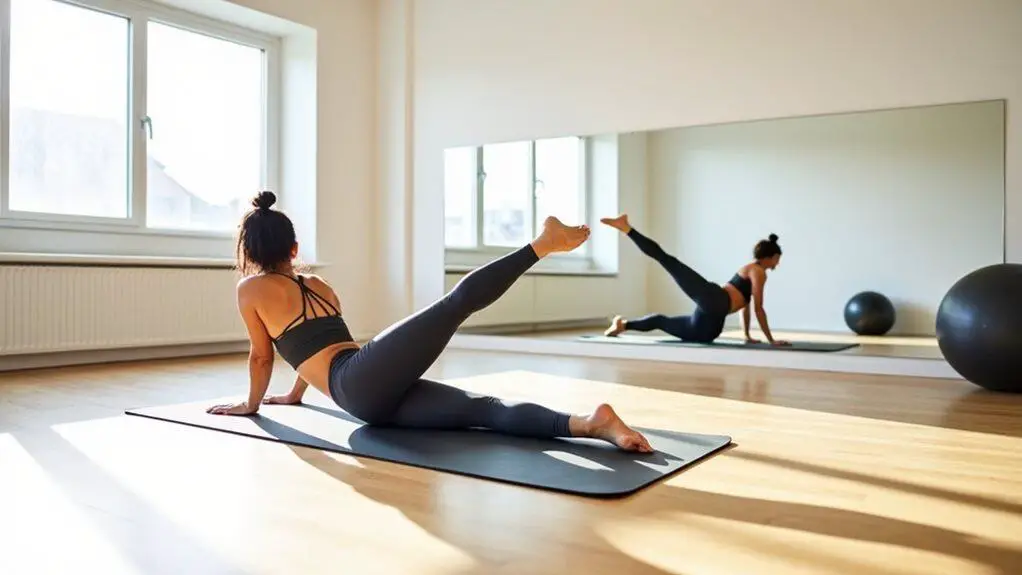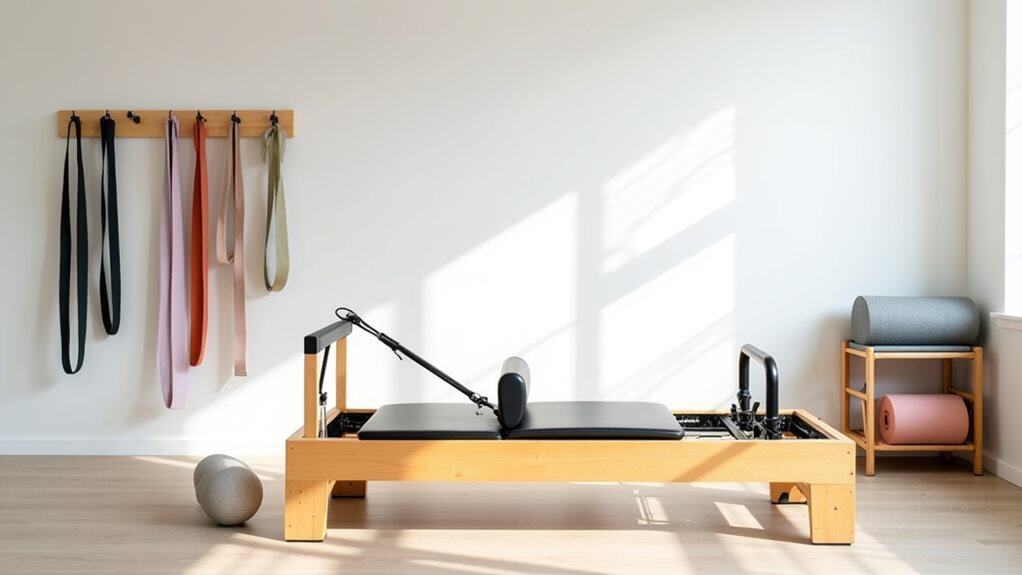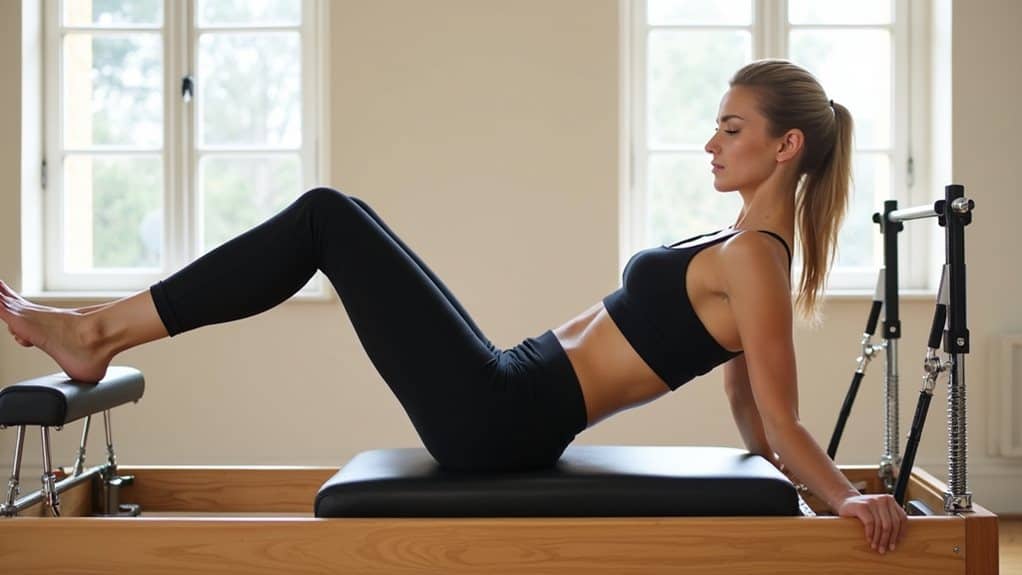Are you looking to ignite the potential of your body and experience a stronger, more flexible you? Look no further than Pilates! This low-impact exercise method has been around for over a century and is renowned for its ability to enhance strength, flexibility, and mental clarity.
Pilates is not just a workout, it’s a lifestyle. It has the power to transform your body and mind, allowing you to move through life with ease and grace.
Whether you are an athlete looking to improve your performance, or simply looking for a way to prevent injury and increase mobility, Pilates has something to offer.
In this article, we will explore the many benefits of Pilates, from its history and core principles to its ability to enhance athletic performance and improve mental focus.
So join us as we uncover the remarkable benefits of Pilates and help you become a stronger, more flexible you!
Key Takeaways
- Pilates is a low-impact exercise method that enhances strength, flexibility, and mental clarity, and promotes overall well-being.
- It is suitable for athletes and injury prevention/rehabilitation, and it was developed by Joseph Pilates for injured soldiers in WWI.
- Pilates emphasizes mind-body connection and strong core, and it can aid in post-injury recovery, pain management, and stress reduction.
- There are two main types of Pilates: mat Pilates and reformer Pilates, both of which can be modified to suit any fitness level. To get started with Pilates, it is important to find a qualified teacher and prioritize proper form and alignment to prevent injury.
The History and Origins of Pilates
Did you know that the origins of Pilates can be traced back to the early 20th century, when Joseph Pilates developed the method as a way to rehabilitate injured soldiers during World War I?
Joseph Pilates believed in the mind-body connection and the importance of a strong core to support the body. His philosophy was that physical fitness is the first requisite of happiness.
Pilates believed that our physical and mental health are connected, and that a balanced and aligned body can lead to a clearer and more focused mind. He developed the method with the intention of creating a comprehensive system that would strengthen the body while also promoting mental clarity and overall well-being.
Pilates believed in the power of movement to heal and transform the body and mind.
Understanding the origins and creator’s philosophy of Pilates is essential to fully embracing the practice. By incorporating the principles of Pilates into our daily lives, we can experience the benefits of a stronger, more flexible body, as well as a clearer and more focused mind.
Now, let’s dive deeper into the core principles of Pilates and how they can ignite your body’s potential.
Understanding the Core Principles
To truly understand Pilates, it’s important to grasp the core principles that form the foundation of this transformative exercise practice.
Proper breathing is one of the key principles of Pilates. It involves inhaling deeply through your nose, expanding your abdomen and ribs, and exhaling slowly through your mouth while contracting your core muscles.
Another essential principle of Pilates is alignment techniques. This involves focusing on the proper alignment of your spine and other joints, which helps to improve your posture and prevent injuries. By aligning your body correctly, you can also work more effectively and efficiently, targeting specific muscle groups and achieving greater results.
By incorporating these core principles into your Pilates practice, you can unlock the full potential of your body. With proper breathing and alignment techniques, you can develop a stronger core, improve your posture, and increase your overall flexibility and mobility.
In the next section, we’ll explore how these principles contribute to increased strength and flexibility, and how you can use them to achieve your fitness goals.
Increased Strength and Flexibility
Get ready to feel the incredible difference in your body’s strength and flexibility through practicing Pilates’ core principles of proper breathing and alignment techniques. Pilates is designed to strengthen and stretch your muscles through dynamic movements and targeted exercises. By focusing on your core, you’ll be able to move with more grace and fluidity, improving your balance and posture along the way.
One of the main benefits of Pilates is increased strength. By targeting specific muscle groups, Pilates helps to build lean muscle mass, which in turn increases your overall strength. This type of strength training is different from lifting heavy weights, which can bulk up your muscles. Instead, Pilates focuses on building long, lean muscles that are strong and flexible. This type of strength training not only helps you look better, but it also improves your quality of life by making everyday tasks easier to accomplish.
In addition to increased strength, Pilates also improves flexibility. By working on your body’s alignment and posture, you’ll be able to move more freely and with greater range of motion. This improved flexibility can help to prevent injury and reduce pain, making it easier to maintain an active lifestyle. Whether you’re an athlete or just someone looking to improve your overall health, Pilates is a great way to unlock your body’s potential.
As we’ve seen, practicing Pilates can help you increase your strength and flexibility, leading to improved balance and posture. But Pilates is also an effective way to prevent and rehabilitate injuries. By focusing on proper alignment and posture, you can reduce the risk of injury during physical activity. And if you do experience an injury, Pilates can be used to help rehabilitate the affected area, helping you get back to your normal activities as soon as possible. With all these benefits, it’s no wonder that Pilates has become such a popular form of exercise.
Injury Prevention and Rehabilitation
Let’s talk about the injury prevention and rehabilitation benefits of Pilates. As a Pilates enthusiast, we know that the practice can help reduce the risk of injury by improving our overall body mechanics and alignment.
In the unfortunate event of an injury, Pilates can also aid in post-injury recovery and pain management, helping us get back to our regular activities with more ease.
Reducing Risk of Injury
By practicing Pilates regularly, we can significantly decrease our chances of sustaining injuries during physical activities. Pilates is a low-impact exercise that focuses on proper alignment, core strength, and flexibility. With its emphasis on controlled movements and breath, it helps us develop body awareness and proper technique, which are essential in preventing injuries.
By engaging in injury-free workouts, we can improve our overall physical health and well-being. Moreover, Pilates is an excellent complement to other physical activities and sports. It can help us enhance our performance by strengthening our core, improving our balance and stability, and reducing muscle imbalances.
By incorporating Pilates into our fitness routine, we can reduce our risk of injury and enjoy our favorite activities with greater ease and confidence. As we move on to the next section about post-injury recovery, we can apply the principles of Pilates to help us regain strength, flexibility, and range of motion.
Post-injury Recovery
If you’ve recently experienced an injury, Pilates can be a great way to aid your recovery and rebuild your strength and flexibility. Many physical therapy programs incorporate Pilates exercises into their regimen as a way to help patients recover from injuries.
Pilates can target specific muscle groups that need to be strengthened and conditioned to help prevent future injuries. In addition to aiding in recovery, Pilates can also provide ongoing muscle conditioning that can help prevent future injuries.
By strengthening and stabilizing the muscles surrounding a previously injured area, Pilates can help reduce the risk of reinjury. The controlled and low-impact movements of Pilates can also be beneficial for those with chronic pain or conditions such as arthritis.
With continued practice, Pilates can help improve overall physical health and mobility. Transitioning into the subsequent section about ‘pain management’, Pilates can also be a great tool for managing chronic pain and discomfort.
Pain Management
Managing chronic pain can be challenging, but Pilates can be a helpful tool in reducing discomfort and improving overall physical well-being. It’s a low-impact exercise that focuses on controlled movements, emphasizing proper alignment, breathing, and body awareness. Here are some reasons why Pilates can be an effective natural remedy for pain management:
- Pilates strengthens the core muscles, which can alleviate pressure on the back and other joints, reducing pain and increasing mobility.
- Pilates improves flexibility, which can help relieve tension in the muscles and reduce stiffness, making it easier to move without pain.
- Pilates promotes better posture, which can reduce strain on the muscles and joints, minimizing pain and discomfort.
- Pilates is a low-impact exercise, making it a suitable alternative therapy for those who may not be able to participate in high-impact activities.
Pilates is a holistic approach to pain management that can be both physically and mentally beneficial. By incorporating Pilates into your routine, you can improve your physical well-being while also promoting mental clarity and focus.
Mental Clarity and Focus
Achieving mental clarity and focus is as easy as incorporating Pilates into your daily routine. This form of exercise is not just about physical activity, but it also emphasizes the mind-body connection, allowing you to take control of your thoughts and emotions.
By focusing on your breath, movements, and alignment, you can release stress and anxiety, leaving you with a clear and focused mind. Pilates is a great stress management tool as it helps you become more aware of your body and mind.
When you practice Pilates, you are forced to slow down and pay attention to your movements, which can help you stay present and mindful. This mindfulness can carry over into your daily life, allowing you to approach challenges with a clear and focused mind. You may find that you are better able to manage stress and anxiety as you become more mindful and aware of your thoughts and feelings.
Incorporating Pilates into your daily routine can help you achieve mental clarity and focus, leading to a more fulfilling life. By practicing Pilates, you can develop a deeper understanding of your body and mind, allowing you to take control of your thoughts and emotions. As you become more mindful and present, you’ll find that you are better equipped to handle the challenges of daily life.
In the next section, we’ll explore how Pilates can enhance your athletic performance, allowing you to reach your full potential.
Enhancing Athletic Performance
To take your athletic performance to the next level, picture yourself effortlessly gliding across the field or court after incorporating Pilates into your daily routine.
Pilates offers sport-specific benefits that can enhance your overall performance, no matter what your chosen sport is. It helps to improve your body’s core strength, balance, and flexibility, which are essential for success in any athletic activity.
Pilates also helps to build endurance, which is crucial for athletes who need to perform at their peak for extended periods of time. It accomplishes this by focusing on controlled movements that engage muscles throughout the entire body. This builds both muscle strength and cardiovascular endurance, leading to improved performance in your sport.
Whether you’re a seasoned athlete or just starting out, Pilates can help you take your performance to the next level. So, incorporate Pilates into your daily routine and start reaping the benefits today.
In the next section, we’ll explore the different types of Pilates and how to find the one that’s right for you.
Different Types of Pilates
Are you curious about the different types of Pilates and which one might be the best fit for you and your fitness goals? Well, there are two main types of Pilates: mat and reformer.
Mat Pilates is performed on a mat and focuses on bodyweight exercises and core strength. On the other hand, reformer Pilates is performed on a machine that uses springs and straps to provide resistance. This type of Pilates is great for building strength, improving flexibility, and targeting specific muscle groups.
When it comes to choosing between mat and reformer Pilates, it really depends on your experience level and fitness goals. Mat Pilates is a great option for beginners because it focuses on the basics and doesn’t require any equipment. However, if you’re looking for a more challenging workout or want to target specific areas of your body, reformer Pilates might be a better fit.
It’s important to note that both types of Pilates can be modified to suit any fitness level. Whether you’re a beginner or an advanced practitioner, Pilates has something to offer everyone. It’s a low-impact workout that can help improve your posture, balance, and overall fitness.
So, if you’re ready to take your fitness to the next level, consider trying Pilates. In the next section, we’ll discuss how to get started with Pilates and what you can expect from your first class.
Getting Started with Pilates
Ready to try Pilates? Let’s discuss how you can get started and what you can expect from your first class. First things first, you need to find a qualified Pilates teacher. You want someone who has been trained by a reputable organization and has experience working with beginners. You can check out local studios, gyms, or even online classes to find a teacher that works for you.
Next, you’ll need to decide if you want to do Pilates mat work or use Pilates equipment. Mat work is great because you can do it anywhere, but using equipment like a Reformer or Cadillac can help deepen your practice. If you choose to use equipment, your teacher will guide you through how to use it properly and safely. Don’t worry if it seems intimidating at first, your teacher will help you adjust the equipment to your body and level of experience.
During your first class, you can expect to learn the basics of Pilates and how to properly engage your core muscles. Your teacher will guide you through various exercises and help you with proper alignment and form. Don’t worry if it seems challenging at first, with practice, Pilates can help you build strength, flexibility, and improve your overall posture. So, get ready to ignite your body’s potential and give Pilates a try!
| Pros of Pilates | Cons of Pilates | Tips for Beginners |
|---|---|---|
| Improved posture | Can be expensive | Start with a qualified teacher |
| Increased flexibility | Results take time | Listen to your body and take breaks if needed |
| Low-impact exercise | Requires focus and concentration | Be patient and consistent with your practice |
| Builds strength | May not be for everyone | Set realistic goals and track your progress |
| Can be modified for all levels | May not be a cardiovascular workout | Don’t compare yourself to others, focus on your own journey |
Remember to prioritize proper form and alignment to prevent injury.
Conclusion
In conclusion, Pilates is an amazing workout that has many benefits. It was created by Joseph Pilates in the early 20th century and has since become a popular form of exercise around the world.
Understanding the core principles of Pilates is essential for achieving the best results. These include increased strength and flexibility, injury prevention and rehabilitation, mental clarity and focus, and enhanced athletic performance.
There are different types of Pilates, including mat work and equipment-based exercises, which can be tailored to suit individual needs and goals. Getting started with Pilates is easy and requires minimal equipment, making it accessible to everyone.
Whether you’re looking to improve your overall fitness, recover from an injury, or simply want to try something new, Pilates is a fantastic choice. So why not ignite your body’s potential and discover the remarkable benefits of Pilates today?
